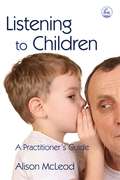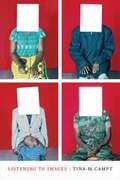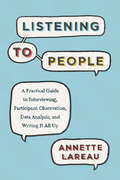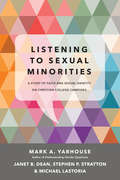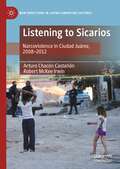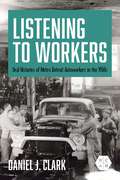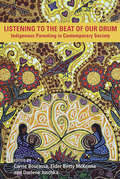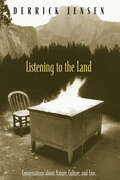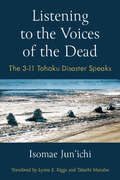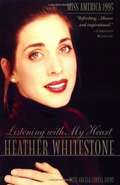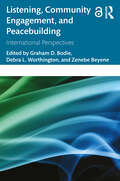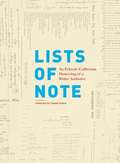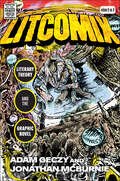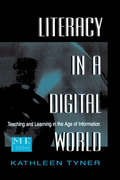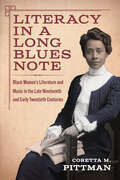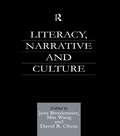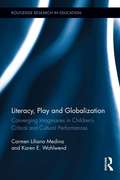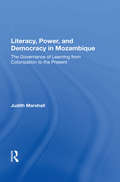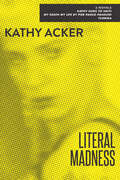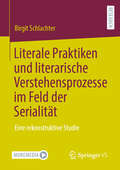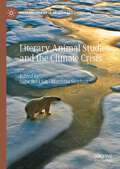- Table View
- List View
Listening to Children: A Practitioner's Guide
by Alison Mcleod'Listening to children' is one of those feel-good phrases that always features in childcare literature as if it were self-evidently a good thing. Often, however, there is a lack of critical attention to what it really means: How does one listen? How can one evidence that listening has taken place? Starting with an introduction to the policy and practice of listening to children and young people, both individually and in groups, this practitioner's guide provides a range of practical techniques for effective listening, encompassing observation and communication, seeing things from the child's point of view, explaining difficult concepts, helping young people to talk about their experiences and express their feelings, promoting participation and eliciting their wishes and views. The book is peppered throughout with good practice checklists, good practice examples, reflective exercises and quotations from children, as well as case studies showing real situations where effective communication has been established with a child. Listening to Children: A Practitioner's Guide is a rich source of insight and guidance for professionals working with children in the fields of social care, health and education, including child welfare protection, pastoral care, educational psychology and counselling, and indeed for anyone working with children.
Listening to Images
by Tina M. CamptIn Listening to Images Tina M. Campt explores a way of listening closely to photography, engaging with lost archives of historically dismissed photographs of black subjects taken throughout the black diaspora. Engaging with photographs through sound, Campt looks beyond what one usually sees and attunes her senses to the other affective frequencies through which these photographs register. She hears in these photos—which range from late nineteenth-century ethnographic photographs of rural African women and photographs taken in an early twentieth-century Cape Town prison to postwar passport photographs in Birmingham, England and 1960s mug shots of the Freedom Riders—a quiet intensity and quotidian practices of refusal. Originally intended to dehumanize, police, and restrict their subjects, these photographs convey the softly buzzing tension of colonialism, the low hum of resistance and subversion, and the anticipation and performance of a future that has yet to happen. Engaging with discourses of fugitivity, black futurity, and black feminist theory, Campt takes these tools of colonialism and repurposes them, hearing and sharing their moments of refusal, rupture, and imagination.
Listening to People: A Practical Guide to Interviewing, Participant Observation, Data Analysis, and Writing It All Up (Chicago Guides to Writing, Editing, and Publishing)
by Annette LareauA down-to-earth, practical guide for interview and participant observation and analysis. In-depth interviews and close observation are essential to the work of social scientists, but inserting one’s researcher-self into the lives of others can be daunting, especially early on. Esteemed sociologist Annette Lareau is here to help. Lareau’s clear, insightful, and personal guide is not your average methods text. It promises to reduce researcher anxiety while illuminating the best methods for first-rate research practice. As the title of this book suggests, Lareau considers listening to be the core element of interviewing and observation. A researcher must listen to people as she collects data, listen to feedback as she describes what she is learning, listen to the findings of others as they delve into the existing literature on topics, and listen to herself in order to sift and prioritize some aspects of the study over others. By listening in these different ways, researchers will discover connections, reconsider assumptions, catch mistakes, develop and assess new ideas, weigh priorities, ponder new directions, and undertake numerous adjustments—all of which will make their contributions clearer and more valuable. Accessibly written and full of practical, easy-to-follow guidance, this book will help both novice and experienced researchers to do their very best work. Qualitative research is an inherently uncertain project, but with Lareau’s help, you can alleviate anxiety and focus on success.
Listening to People: A Practical Guide to Interviewing, Participant Observation, Data Analysis, and Writing It All Up (Chicago Guides to Writing, Editing, and Publishing)
by Annette LareauA down-to-earth, practical guide for interview and participant observation and analysis. In-depth interviews and close observation are essential to the work of social scientists, but inserting one’s researcher-self into the lives of others can be daunting, especially early on. Esteemed sociologist Annette Lareau is here to help. Lareau’s clear, insightful, and personal guide is not your average methods text. It promises to reduce researcher anxiety while illuminating the best methods for first-rate research practice. As the title of this book suggests, Lareau considers listening to be the core element of interviewing and observation. A researcher must listen to people as she collects data, listen to feedback as she describes what she is learning, listen to the findings of others as they delve into the existing literature on topics, and listen to herself in order to sift and prioritize some aspects of the study over others. By listening in these different ways, researchers will discover connections, reconsider assumptions, catch mistakes, develop and assess new ideas, weigh priorities, ponder new directions, and undertake numerous adjustments—all of which will make their contributions clearer and more valuable. Accessibly written and full of practical, easy-to-follow guidance, this book will help both novice and experienced researchers to do their very best work. Qualitative research is an inherently uncertain project, but with Lareau’s help, you can alleviate anxiety and focus on success.
Listening to People: A Practical Guide to Interviewing, Participant Observation, Data Analysis, and Writing It All Up (Chicago Guides to Writing, Editing, and Publishing)
by Annette LareauA down-to-earth, practical guide for interview and participant observation and analysis. In-depth interviews and close observation are essential to the work of social scientists, but inserting one’s researcher-self into the lives of others can be daunting, especially early on. Esteemed sociologist Annette Lareau is here to help. Lareau’s clear, insightful, and personal guide is not your average methods text. It promises to reduce researcher anxiety while illuminating the best methods for first-rate research practice. As the title of this book suggests, Lareau considers listening to be the core element of interviewing and observation. A researcher must listen to people as she collects data, listen to feedback as she describes what she is learning, listen to the findings of others as they delve into the existing literature on topics, and listen to herself in order to sift and prioritize some aspects of the study over others. By listening in these different ways, researchers will discover connections, reconsider assumptions, catch mistakes, develop and assess new ideas, weigh priorities, ponder new directions, and undertake numerous adjustments—all of which will make their contributions clearer and more valuable. Accessibly written and full of practical, easy-to-follow guidance, this book will help both novice and experienced researchers to do their very best work. Qualitative research is an inherently uncertain project, but with Lareau’s help, you can alleviate anxiety and focus on success.
Listening to Sexual Minorities: A Study of Faith and Sexual Identity on Christian College Campuses (Christian Association for Psychological Studies Books)
by Mark A. Yarhouse Janet B. Dean Stephen P. Stratton Michael LastoriaListening to Sexual Minorities
Listening to Sicarios: Narcoviolence in Ciudad Juárez, 2008-2012 (New Directions in Latino American Cultures)
by Robert McKee Irwin Arturo Chacón CastañónListening to Sicarios presents new insights into the lives of paid assassins of Mexico’s drug trafficking syndicates from the perspectives of the assassins themselves. Based on an extraordinary series of ethnographic interviews carried out in the wake of the record levels of narcoviolence experienced in Ciudad Juárez between 2008 and 2012, this study analyzes the ways in which these young men interpret their actions across four key thematic axes: border infrastructures, youth and responsibility, masculinity and sentiment, and ethics: good vs. evil.It argues that sicarios follow a career path within a criminal corporate infrastructure that is especially robust in Mexican border cities. It also explores how sicarios understand youthful innocence in relation to adult accountability in the realm of violence that is frequently meted out by young men on other young men. It then analyzes sicarios’ expressions of feelings of power that may boost their sense of virility, as well as feelings of fear and regret that imply weakness. Finally, it examines how sicarios defend their personal integrity in the face of a public discourse that views their acts as savage.
Listening to Workers: Oral Histories of Metro Detroit Autoworkers in the 1950s (Working Class in American History)
by Daniel J. ClarkHistorians and readers alike often overlook the everyday experiences of workers. Drawing on years of interviews and archival research, Daniel J. Clark presents the rich, interesting, and sometimes confounding lives of men and women who worked in Detroit-area automotive plants in the 1950s. In their own words, the interviewees frankly discuss personal matters like divorce and poverty alongside recollections of childhood and first jobs, marriage and working women, church and hobbies, and support systems and workplace dangers. Their frequent struggles with unstable jobs and economic insecurity upend notions of the 1950s as a golden age of prosperity while stories of domestic violence and infidelity open a door to intimate aspects of their lives. Taken together, the narratives offer seldom-seen accounts of autoworkers as complex and multidimensional human beings. Compelling and surprising, Listening to Workers foregoes the union-focused strain of labor history to provide ground-level snapshots of a blue-collar world.
Listening to the Beat of the Drum: Parenting In Contemporary Society
by Carrie McKenna BourassaListening to the Beat of Our Drum: Indigenous Parenting in a Contemporary Society is a collection of stories, inspired by a wealth of experiences across space and time from a kokum, an auntie, two-spirit parents, a Metis mother, a Tlinglit/Anishnabe Métis mother and an allied feminist mother. This book is born out of the need to share experiences and story. Storytelling is one of the most powerful forms of passing on teachings and values that we have in our Indigenous communities. This book weaves personal stories to explore mothering practices and examines historical contexts and underpinnings that contribute to contemporary parenting practices. We share our stories with the hope that it will resonate with readers whether they are in the classroom or in the community. Like our contributors, we are from all walks of life, sharing diverse perspectives about mothering whether it be as a mother, auntie, kokum or other adopted role.
Listening to the Land: Conversations about Nature, Culture and Eros
by Derrick JensenIn this far-ranging and heartening collection, Derrick Jensen gathers conversations with environmentalists, theologians, Native Americans, psychologists, and feminists, engaging some of our best minds in an exploration of more peaceful ways to live on Earth. Included here is Dave Foreman on biodiversity, Matthew Fox on Christianity and nature, Jerry Mander on technology, and Terry Tempest Williams on an erotic connection to the land. With intelligence and compassion, Listening to the Land moves from a look at the condition of the environment and the health of our spirit to a beautiful evocation of eros and a life based on love.
Listening to the Voices of the Dead: The 3-11 Tohoku Disaster Speaks (Michigan Monograph Series in Japanese Studies #103)
by Jun'ichi IsomaeListening to the Voices of the Dead is an account of the author’s search for the disquieted voices of the dead in the wake of the March 11, 2011, Tōhoku Disaster and his attempt to translate those voices for the living. Isomae Jun’ichi considers the disaster a challenge for outside observers to overcome, especially for practitioners of religion and religious studies. He chronicles the care and devotion for the dead shown by ordinary people, people displaced from their homes and loved ones. Drawing upon religious studies, Japanese history, postcolonial studies, and his own experiences during the disaster, Isomae uncovers historical symptoms brought to the surface by the traumas of disaster. Only by listening to the disquieted voices of the dead, translating them, and responding to them can we regain our true selves as well as offer peace to the spirits of the victims. While Listening to the Voices of the Dead focuses on a specific event in Japanese history and memory, it captures a broadening critique at the heart of many movements responding to how increasing globalization impacts our sense of place and community.
Listening with My Heart
by Angela Elwell Hunt Heather Whitestone<P>Heather Whitestone. Her name has become synonymous with incredible determination and unprecedented achievement. In Listening with My Heart, Heather tells her own story and the stories of others who have inspired her, proving that with hard work, perseverance, and faith, each of us can move mountains. <P>Profoundly deaf since she was eighteen months old, Heather strove to live a normal life, and refused to listen to the voices of discouragement that many of us so often hear, no matter what problems confront us. She wouldn't listen to the doctor who said she wouldn't develop beyond third-grade abilities, or to those who said she would never dance ballet, or even speak. She did, however, hear the encouraging spirit of her family and followed the guidance of her own heart's dreams. <P>Struggling through her difficulties, she was sustained by every success--no matter how small--and ultimately became Miss America 1995. Though she is disabled, her incredible gifts have inspired many throughout the world, and in Listening with My Heart she at last shares her life-changing wisdom.
Listening, Community Engagement, and Peacebuilding: International Perspectives
by Debra L. Worthington Graham D. Bodie Zenebe BeyeneThis book explores the role of listening in community engagement and peacebuilding efforts, bridging academic research in communication and practical applications for individual and social change. For all their differences, community engagement and peacebuilding efforts share much in common: the need to establish and agree on achievable and measurable goals, the importance of trust, and the need for conflict management, to name but a few. This book presents listening – considered as a multi-disciplinary concept related to but distinct from civility, civic participation, and other social processes – as a primary mechanism for accomplishing these tasks. Individual chapters explore these themes in an array of international contexts, examining topics such as conflict resolution, restorative justice, environmental justice, migrants and refugees, and trauma-informed peacebuilding. The book includes contemporary literature reviews and theoretical insights covering the role of listening as related to individual, social, and governmental efforts to better engage communities and build, maintain, or establish peace in an increasingly divided world. This collection provides invaluable insight to researchers, students, educators, and practitioners in intercultural and international communication, conflict management, peacebuilding, community engagement, and international studies.
Listening, Community Engagement, and Peacebuilding: International Perspectives
by Debra L. Worthington Zenebe BeyeneThis book explores the role of listening in community engagement and peacebuilding efforts, bridging academic research in communication and practical applications for individual and social change.For all their differences, community engagement and peacebuilding efforts share much in common: the need to establish and agree on achievable and measurable goals, the importance of trust, and the need for conflict management, to name but a few. This book presents listening – considered as a multi-disciplinary concept related to but distinct from civility, civic participation, and other social processes – as a primary mechanism for accomplishing these tasks. Individual chapters explore these themes in an array of international contexts, examining topics such as conflict resolution, restorative justice, environmental justice, migrants and refugees, and trauma-informed peacebuilding. The book includes contemporary literature reviews and theoretical insights covering the role of listening as related to individual, social, and governmental efforts to better engage communities and build, maintain, or establish peace in an increasingly divided world.This collection provides invaluable insight to researchers, students, educators, and practitioners in intercultural and international communication, conflict management, peacebuilding, community engagement, and international studies.Chapter 10 of this book is freely available as a downloadable Open Access PDF at http://www.taylorfrancis.com under a Creative Commons Attribution-Non Commercial-No Derivatives (CC-BY-ND) 4.0 license.
Lists of Note
by Shaun UsherLists of Note curates 125 unputdownable entries from a list of names that are as eclectic and intriguing as its contents, which include myriad reasons given by ancient Egyptians for missing work, Albert Einstein's demands of his estranged wife, F. Scott Fitzgerald's extensive conjugation of "to cocktail," and many more. Rarely intended for the public eye, these lists reveal hopes, priorities, and musings in a most engaging and entertaining way. Each transcript is accompanied by an artwork, most a captivating facsimile of the list itself. Richly visual and irresistibly readable, Lists of Note is a testament to the human urge to bring order to, poke fun at, and find meaning in the world around us--and is a gift of endless enjoyment and lasting value.
Litcomix: Literary Theory and the Graphic Novel
by Adam Geczy Jonathan McBurnieCritical studies of the graphic novel have often employed methodologies taken from film theory and art criticism. Yet, as graphic novels from Maus to Watchmen have entered the literary canon, perhaps the time has come to develop theories for interpreting and evaluating graphic novels that are drawn from classic models of literary theory and criticism. Using the methodology of Georg Lukács and his detailed defense of literary realism as a socially embedded practice, Litcomix tackles difficult questions about reading graphic novels as literature. What critical standards should we use to measure the quality of a graphic novel? How does the genre contribute to our understanding of ourselves and the world? What qualities distinguish it from other forms of literature? LitComix hones its theoretical approach through case studies taken from across the diverse world of comics, from Yoshihiro Tatsumi’s groundbreaking manga to the Hernandez Brothers’ influential alt-comix. Whether looking at graphic novel adaptations of Proust or considering how Jack Kirby’s use of intertextuality makes him the Balzac of comics, this study offers fresh perspectives on how we might appreciate graphic novels as literature.
Literacy in a Digital World: Teaching and Learning in the Age of Information (Routledge Communication Series)
by Kathleen TynerIn this book, Kathleen Tyner examines the tenets of literacy through a historical lens to demonstrate how new communication technologies are resisted and accepted over time. New uses of information for teaching and learning create a "disconnect" in the complex relationship between literacy and schooling, and raise questions about the purposes of literacy in a global, networked, educational environment. The way that new communication technologies change the nature of literacy in contemporary society is discussed as a rationale for corresponding changes in schooling. Digital technologies push beyond alphabetic literacy to explore the way that sound, image, and text can be incorporated into education. Attempts to redefine literacy terms--computer, information, technology, visual, and media literacies--proliferate and reflect the need to rethink entrenched assumptions about literacy. These multiple literacies are advanced to help users make sense of the information glut by fostering the ability to access, analyze, and produce communication in a variety of forms. Tyner explores the juncture between two broad movements that hope to improve education: educational technology and media education. A comparative analysis of these two movements develops a vision of teaching and learning that is critical, hands on, inquiry-based, and suitable for life in a mobile, global, participatory democracy.
Literacy in a Long Blues Note: Black Women’s Literature and Music in the Late Nineteenth and Early Twentieth Centuries (Margaret Walker Alexander Series in African American Studies)
by Coretta M. PittmanLiteracy in a Long Blues Note: Black Women’s Literature and Music in the Late Nineteenth and Early Twentieth Centuries traces the evolution of Black women’s literacy practices from 1892 to 1934. A dynamic chronological study, the book explores how Black women public intellectuals, creative writers, and classic blues singers sometimes utilize singular but other times overlapping forms of literacies to engage in debates on race. The book begins with Anna J. Cooper’s philosophy on race literature as one method for social advancement. From there, author Coretta M. Pittman discusses women from the Woman’s and New Negro Eras, including but not limited to Angelina Weld Grimké, Gertrude “Ma” Rainey, and Zora Neale Hurston. The volume closes with an exploration of Victoria Spivey’s blues philosophy. The women examined in this book employ forms of transformational, transactional, or specular literacy to challenge systems of racial oppression. However, Literacy in a Long Blues Note argues against prevalent myths that a singular vision for racial uplift dominated the public sphere in the latter decade of the nineteenth century and the early decades of the twentieth century. Instead, by including Black women from various social classes and ideological positions, Pittman reveals alternative visions. Contrary to more moderate predecessors of the Woman’s Era and contemporaries in the New Negro Era, classic blues singers like Mamie Smith advanced new solutions against racism. Early twentieth-century writer Angelina Weld Grimké criticized traditional methods for racial advancement as Jim Crow laws tightened restrictions against Black progress. Ultimately, the volume details the agency and literacy practices of these influential women.
Literacy, Narrative and Culture
by Min Wang David R. Olson Jens BrockmeierAn important contribution to the multi-disciplinary study of literacy, narrative and culture, this work argues that literacy is perhaps best described as an ensemble of socially and historically embedded activities of cultural practices. It suggests viewing written language, producing and distributing, deciphering and interpreting signs, are closely related to other cultural practices such as narrative and painting. The papers of the first and second parts illustrate this view in contexts that range from the pre-historical beginnings of tracking signs' in hunter-gatherer cultures, and the emergence of modern literate traditions in Europe in the 17th to 19th century, to the future of electronically mediated writing in times of the post-Gutenberg galaxy. The chapters of the third present results of recent research in developmental and educational psychology. Contributions by leading experts in the field make the point that there is no theory and history of writing that does not presuppose a theory of culture and social development. At the same time, it demonstrates that every theory and history of culture must unavoidably entail a theory and history of writing and written culture. This book brings together perspectives on literacy from psychology, linguistics, history and sociology of literature, philosophy, anthropology, and history of art. It addresses these issues in plain language – not coded in specialized jargon – and addresses a multi-disciplinary forum of scholars and students of literacy, narrative and culture.
Literacy, Play and Globalization: Converging Imaginaries in Children's Critical and Cultural Performances (Routledge Research in Education #115)
by Carmen L. Medina Karen E. WohlwendThis book takes on current perspectives on children’s relationships to literacy, media, childhood, markets and transtionalism in converging global worlds. It introduces the idea of multi-sited imaginaries to explain how children’s media and literacy performances shape and are shaped by shared visions of communities that we collectively imagine, including play, media, gender, family, school, or cultural worlds. It draws upon elements of ethnographies of globalization, nexus analysis and performance theories to examine the convergences of such imaginaries across multiple sites: early childhood and elementary classrooms and communities in Puerto Rico and the Midwest United States. In this work we attempt to understand that the local moment of engagement within play, dramatic experiences, and literacies is not a given but is always emerging from and within the multiple localities children navigate and the histories, possibilities and challenges they bring to the creative moment.
Literacy, Power, And Democracy In Mozambique: The Governance Of Learning From Colonization To The Present
by Judith MarshallThis book explores the relations between literacy and "people's power" in the context of Mozambique's project of socialist construction. It probes the tensions between literacy as a tool for grassroots democracy versus literacy as a tool for mobilizing at the base for top-down initiatives.
Literal Madness: 3 Novels: Kathy Goes to Haiti, My Death My Life by Pier Paolo Pasolini, and Florida
by Kathy AckerA collection of three novels from the experimental feminist writer: “Literal Madness is Acker at her most powerful, disturbing, and provocative.” —Catherine Texier, author of VictorineKathy Goes to Haiti, the first of three novels in Literal Madness, “speaks to us out of a delightful mock-naivete that reminds one at times of the Dick and Jane readers rewritten as manuals for politics and sex . . . At once hilarious and terrifying, [it] has all the logic of a Caribbean tour and a nightmare combined” (Los Angeles Times).My Death My Life by Pier Paolo Pasolini—wherein, among other things, the late Italian filmmaker solves his own murder, with the help of, among others, Romeo, Juliet, and the Bronté sisters—is a “scathing commentary on false values in art” (The Hartford Courant).In the haunting Florida, Acker achieves “a nearly telegraphic reduction of the Bogart-Bacall movie Key Largo to fatalistic, tough-guy essentials” (Booklist).“There’s a haunting method to Acker’s ‘madness’: a rough, raw, erudite wail against the postmodern loss of meaning and emotion.” —Kirkus Reviews
Literale Praktiken und literarische Verstehensprozesse im Feld der Serialität: Eine rekonstruktive Studie
by Birgit SchlachterBirgit Schlachter begründet theoretisch und empirisch eine Theorie literaler Praktiken, die in praxeologischer und individuell-kognitiver Perspektive den außerschulischen Literalitätserwerb und die Interpretationskultur im Handlungsraum eines Online-Forums zur Jugendromantrilogie „Die Tribute von Panem“ fokussiert. Im Zuge der Rekonstruktion von literarischen Verstehensprozessen rücken insbesondere emotional-wertende Rezeptionsprozesse und deren Einfluss auf das Verstehen eines literarischen Textes in den Blick. Ausgangspunkt der GTM-Studie ist ein Serialitätskonzept, das auf der Textbasis von rund 50 mehrbändigen Serien und Zyklen der aktuellen Jugendliteratur entwickelt wurde und das literale Praktiken von Leserinnen und Lesern einschließt.
Literarische Gestaltung jüdischer Identität bei Maxim Biller und Doron Rabinovici: Vier Romane im Schatten der Shoah und im Widerschein Israels
by Marcel MatthiesDie vorliegende Studie verfolgt das Anliegen, die komplexen und schwierigen Fragen jüdischer Identität und Selbstbeschreibung in der deutsch-jüdischen Gegenwartsliteratur einer fundierten Analyse zu unterziehen. Im Mittelpunkt der Untersuchung stehen Maxim Billers Romane Biografie (2016) und Sechs Koffer (2018) sowie Doron Rabinovicis Roman Andernorts (2010) und der (von ihm in Co-Autorschaft mit Natan Sznaider verfasste) Roman Herzl Relo@ded (2016). Beide viel beachteten Autoren bringen die Fragen innerjüdischen Selbstverständnisses ebenso in den Blick wie sie die Rollen Deutschlands, Österreichs und Israels als Kulissen und Resonanzräume für jüdische Existenz in der Gegenwart thematisieren. Im Zentrum der Interpretationen steht die Fragestellung, wie die jüdische Identitätsthematik in den vier Romanen bearbeitet und literarisch gestaltet wird. Die literaturwissenschaftliche Arbeit sucht die vor allem der Neuheit der Romane geschuldete Forschungslücke mithilfe politischer und soziologischer Theorie, psychoanalytischen und sozialpsychologischen Ansätzen sowie Impulsen aus der Gedächtnis- und Ideengeschichte zu schließen.
Literary Animal Studies and the Climate Crisis (Palgrave Studies in Animals and Literature)
by Matthias Stephan Sune BorkfeltLiterary Animal Studies and the Climate Crisis connects insights from the field of literary animal studies with the urgent issues of climate change and environmental degradation, and features considerations of new interventions by literature in relation to these pressing questions and debates. This volume informs academic debates in terms of how nonhuman animals figure in our cultural imagination of topics such as climate change, extinction, animal otherness, the posthuman, and environmental crises. Using a diverse set of methodologies, each chapter presents relevant cases which discuss the various aspects of these interstices. This volume is an intersection between literary animal studies and climate fiction intended as an interdisciplinary intervention that speaks to the global climate debate and is thus relevant across the environmental humanities.
